2021 HYUNDAI ELANTRA HYBRID recommended oil
[x] Cancel search: recommended oilPage 12 of 555
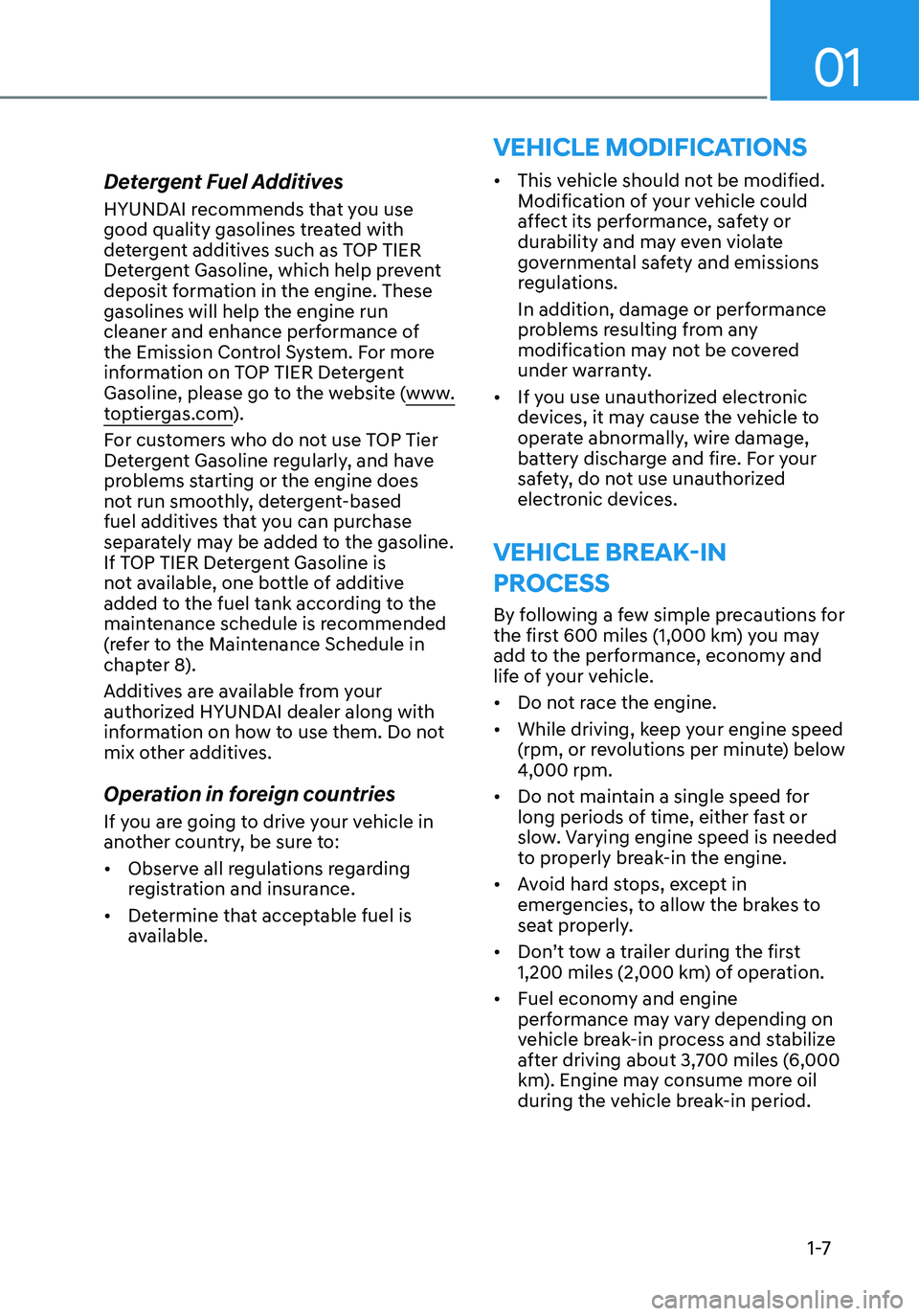
01
1 -7
Detergent Fuel Additives
HYUNDAI recommends that you use
good quality gasolines treated with
detergent additives such as TOP TIER
Detergent Gasoline, which help prevent
deposit formation in the engine. These
gasolines will help the engine run
cleaner and enhance performance of
the Emission Control System. For more
information on TOP TIER Detergent
Gasoline, please go to the website (www.
toptiergas.com ).
For customers who do not use TOP Tier
Detergent Gasoline regularly, and have
problems starting or the engine does
not run smoothly, detergent-based
fuel additives that you can purchase
separately may be added to the gasoline.
If TOP TIER Detergent Gasoline is
not available, one bottle of additive
added to the fuel tank according to the
maintenance schedule is recommended
(refer to the Maintenance Schedule in
chapter 8).
Additives are available from your
authorized HYUNDAI dealer along with
information on how to use them. Do not
mix other additives.
Operation in foreign countries
If you are going to drive your vehicle in
another country, be sure to:
• Observe all regulations regarding
registration and insurance.
• Determine that acceptable fuel is
available. •
This vehicle should not be modified.
Modification of your vehicle could
affect its performance, safety or
durability and may even violate
governmental safety and emissions
regulations.
In addition, damage or performance
problems resulting from any
modification may not be covered
under warranty.
• If you use unauthorized electronic
devices, it may cause the vehicle to
operate abnormally, wire damage,
battery discharge and fire. For your
safety, do not use unauthorized
electronic devices.
VEHICLE BREAK-IN
PROCESS
By following a few simple precautions for
the first 600 miles (1,000 km) you may
add to the performance, economy and
life of your vehicle.
• Do not race the engine.
• While driving, keep your engine speed
(rpm, or revolutions per minute) below
4,000 rpm.
• Do not maintain a single speed for
long periods of time, either fast or
slow. Varying engine speed is needed
to properly break-in the engine.
• Avoid hard stops, except in
emergencies, to allow the brakes to
seat properly.
• Don’t tow a trailer during the first
1,200 miles (2,000 km) of operation.
• Fuel economy and engine
performance may vary depending on
vehicle break-in process and stabilize
after driving about 3,700 miles (6,000
km). Engine may consume more oil
during the vehicle break-in period.
VEHICLE MODIFICATIONS
Page 40 of 555
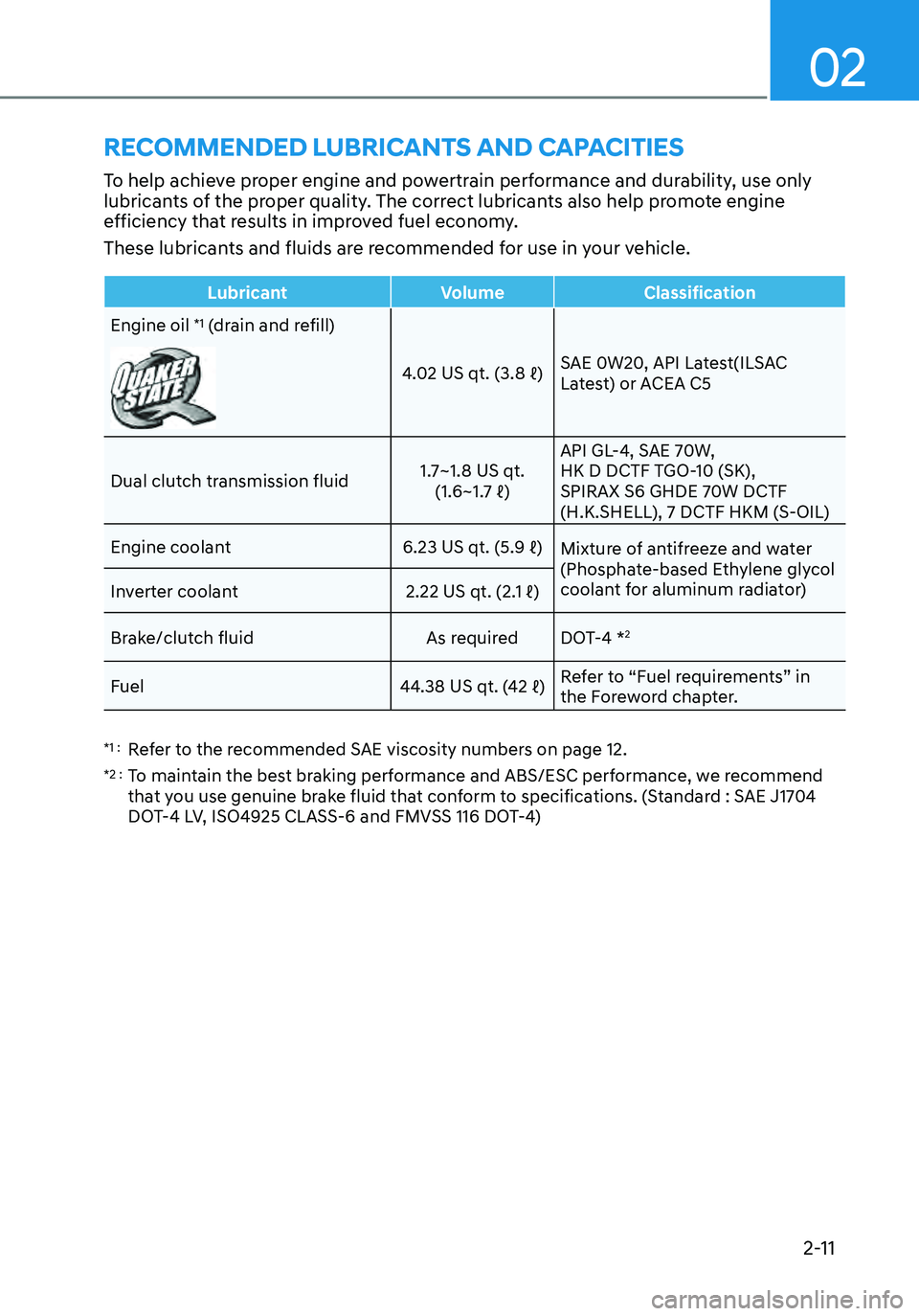
02
2-11
RECOMMENDED LUBRICANTS AND CAPACITIES
To help achieve proper engine and powertrain performance and durability, use only
lubricants of the proper quality. The correct lubricants also help promote engine
efficiency that results in improved fuel economy.
These lubricants and fluids are recommended for use in your vehicle.
LubricantVolumeClassification
Engine oil
*1 (drain and refill)
4.02 US qt. (3.8 ℓ)SAE 0W20, API Latest(ILSAC
Latest) or ACEA C5
Dual clutch transmission fluid1.7~1.8 US qt.(1.6~1.7 ℓ)
API GL-4, SAE 70W,
HK D DCTF TGO-10 (SK),
SPIRAX S6 GHDE 70W DCTF
(H.K.SHELL), 7 DCTF HKM (S-OIL)
Engine coolant
6.23 US qt. (5.9 ℓ)Mixture of antifreeze and water
(Phosphate-based Ethylene glycol
coolant for aluminum radiator)
Inverter coolant
2.22 US qt. (2.1 ℓ)
Brake/clutch fluid As required DOT-4 *2
Fuel
44.38 US qt. (42 ℓ)Refer to “Fuel requirements” in
the Foreword chapter.
*1 : Refer to the recommended SAE viscosity numbers on page 12.
*2 : To maintain the best braking performance and ABS/ESC performance, we recommend
that you use genuine brake fluid that conform to specifications. (Standard : SAE J1704
DOT-4 LV, ISO4925 CLASS-6 and FMVSS 116 DOT-4)
Page 41 of 555
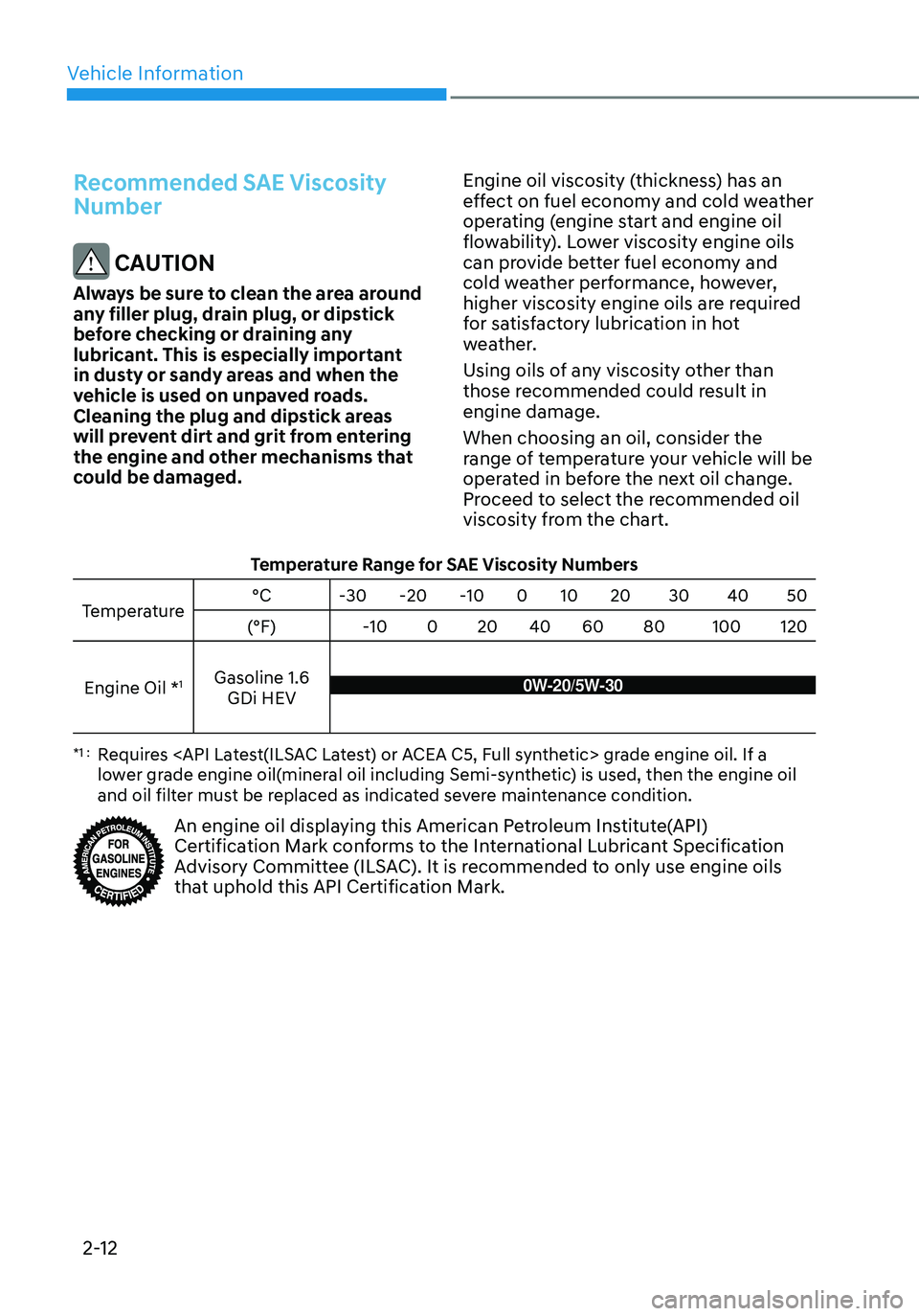
Vehicle Information
2-12
Recommended SAE Viscosity
Number
CAUTION
Always be sure to clean the area around
any filler plug, drain plug, or dipstick
before checking or draining any
lubricant. This is especially important
in dusty or sandy areas and when the
vehicle is used on unpaved roads.
Cleaning the plug and dipstick areas
will prevent dirt and grit from entering
the engine and other mechanisms that
could be damaged.Engine oil viscosity (thickness) has an
effect on fuel economy and cold weather
operating (engine start and engine oil
flowability). Lower viscosity engine oils
can provide better fuel economy and
cold weather performance, however,
higher viscosity engine oils are required
for satisfactory lubrication in hot
weather.
Using oils of any viscosity other than
those recommended could result in
engine damage.
When choosing an oil, consider the
range of temperature your vehicle will be
operated in before the next oil change.
Proceed to select the recommended oil
viscosity from the chart.
Temperature Range for SAE Viscosity Numbers
Temperature °C
-30 -20 -10 0 10 20 30 40 50
(°F) -10 0 20 40 60 80 100 120
Engine Oil *
1Gasoline 1.6 GDi HEV0W-20/5W-30
*1 : Requires
lower grade engine oil(mineral oil including Semi-synthetic) is used, then the engine oil
and oil filter must be replaced as indicated severe maintenance condition.
An engine oil displaying this American Petroleum Institute(API)
Certification Mark conforms to the International Lubricant Specification
Advisory Committee (ILSAC). It is recommended to only use engine oils
that uphold this API Certification Mark.
Page 315 of 555

06
6-47
Winter Precautions
Use high quality ethylene glycol
coolant
Your vehicle is delivered with high
quality ethylene glycol coolant in the
cooling system. It is the only type of
coolant that should be used because it
helps prevent corrosion in the cooling
system, lubricates the water pump and
prevents freezing. Be sure to replace or
replenish your coolant in accordance
with the maintenance schedule in
chapter 8. Before winter, have your
coolant tested to assure that its freezing
point is sufficient for the temperatures
anticipated during the winter.
Change to "winter weight" oil if
necessary
In some climates it is recommended that
a lower viscosity "winter weight" oil be
used during cold weather. See chapter 8
for recommendations. If you aren't sure
what weight oil you should use, consult
an authorized HYUNDAI dealer.
Check battery and cables
Winter puts additional burdens on the
battery system. Visually inspect the
battery and cables as described in
chapter 8. The level of charge in your
battery can be checked by an authorized
HYUNDAI dealer or a service station.
Check spark plugs and ignition
system
Inspect your spark plugs as described in
chapter 8 and replace them if necessary.
Also check all ignition wiring and
components to be sure they are not
cracked, worn or damaged in any way.
Use approved window washer anti-
freeze in system
To keep the water in the window washer
system from freezing, add an approved
window washer anti-freeze solution in
accordance with instructions on the
container. Window washer anti-freeze is available
from an authorized HYUNDAI dealer
and most auto parts outlets. Do not
use engine coolant or other types of
antifreeze as these may damage the
paint finish.
Do not let your parking brake freeze
Under some conditions your parking
brake can freeze in the engaged position.
This is most likely to happen when
there is an accumulation of snow or
ice around or near the rear brakes or
if the brakes are wet. If there is a risk
the parking brake may freeze, apply
it only temporarily while you put the
gear selector lever in P and block the
rear wheels so the car cannot roll. Then
release the parking brake.
Do not let ice and snow accumulate
underneath
Under some conditions, snow and ice
can build up under the fenders and
interfere with the steering. When driving
in severe winter conditions where this
may happen, you should periodically
check underneath the car to be sure the
movement of the front wheels and the
steering components is not obstructed.
Don't place foreign objects
or materials in the engine
compartment
Placement of foreign object or materials
which prevent cooling of the engine, in
the engine compartment, may cause a
failure or combustion. The manufacturer
is not responsible for the damage caused
by such placement.
To keep locks from freezing
To keep the locks from freezing, squirt
an approved de-icer fluid or glycerine
into the key opening. If a lock is covered
with ice, squirt it with an approved de-
icing fluid to remove the ice. If the lock
is frozen internally, you may be able to
thaw it out by using a heated key. Handle
the heated key with care to avoid injury.
Page 476 of 555
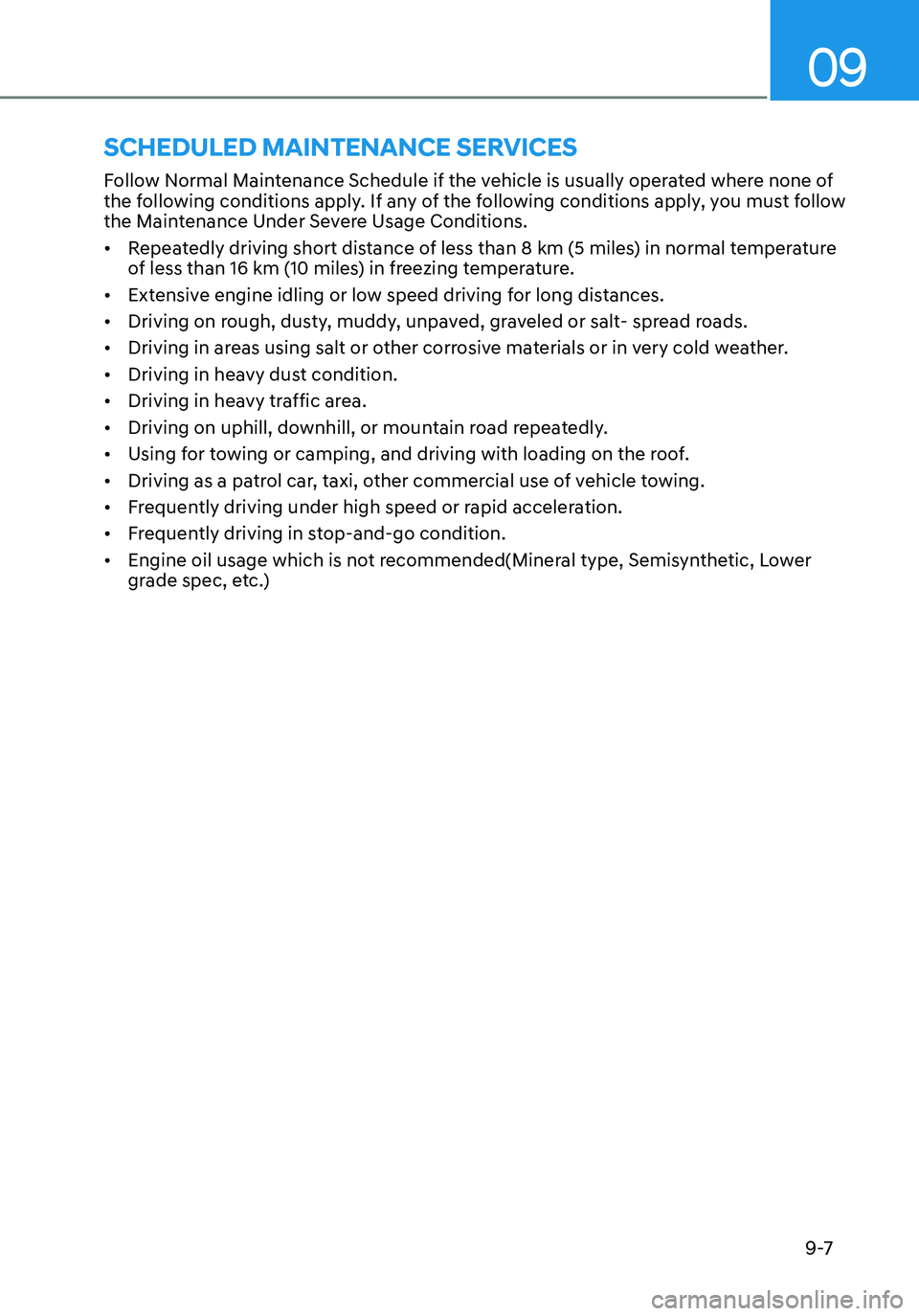
09
9 -7
Follow Normal Maintenance Schedule if the vehicle is usually operated where none of
the following conditions apply. If any of the following conditions apply, you must follow
the Maintenance Under Severe Usage Conditions.
• Repeatedly driving short distance of less than 8 km (5 miles) in normal temperature
of less than 16 km (10 miles) in freezing temperature.
• Extensive engine idling or low speed driving for long distances.
• Driving on rough, dusty, muddy, unpaved, graveled or salt- spread roads.
• Driving in areas using salt or other corrosive materials or in very cold weather.
• Driving in heavy dust condition.
• Driving in heavy traffic area.
• Driving on uphill, downhill, or mountain road repeatedly.
• Using for towing or camping, and driving with loading on the roof.
• Driving as a patrol car, taxi, other commercial use of vehicle towing.
• Frequently driving under high speed or rapid acceleration.
• Frequently driving in stop-and-go condition.
• Engine oil usage which is not recommended(Mineral type, Semisynthetic, Lower
grade spec, etc.)
SCHEDULED MAINTENANCE SERVICES
Page 477 of 555
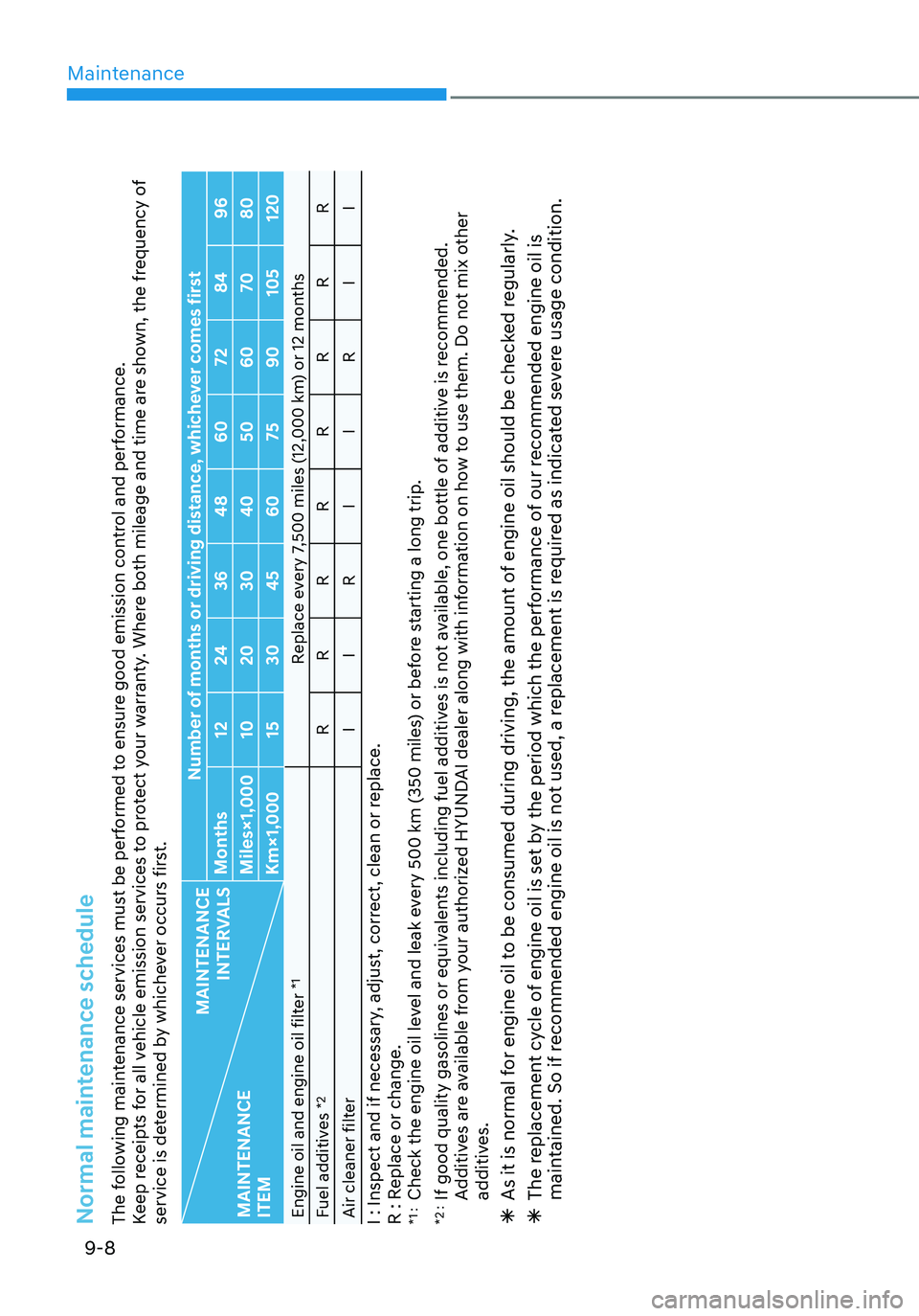
Maintenance
9-8
Normal maintenance schedule The following maintenance services must be performed to ensure good emission control and performance.
Keep receipts for all vehicle emission services to protect your warranty. Where both mileage and time are shown, the frequency of
service is determined by whichever occurs first.
MAINTENANCE
INTERVALS
MAINTENANCE
ITEM Number of months or driving distance, whichever comes first
Months 1224 3648 60 7284 96
Miles×1,000 1020 3040 5060 7080
Km×1,000 1530 4560 7590105 120
Engine oil and engine oil filter
*1
Replace every 7,500 miles (12,000 km) or 12 months
Fuel additives
*2
R RRRRRRR
Air cleaner filter IIR IIR II
I : Inspect and if necessary, adjust, correct, clean or replace.
R : Replace or change.*1 : Check the engine oil level and leak every 500 km (350 miles) or before starting a long trip.
*2 : If good quality gasolines or equivalents including fuel additives is not available, one bottle of additive is recommended.
Additives are available from your authorized HYUNDAI dealer along with information on how to use them. Do not mix other
additives. ÃAs it is normal for engine oil to be consumed during driving, the amount of engine oil should be checked regularly. ÃThe replacement cycle of engine oil is set by the period which the performance of our recommended engine oil is
maintained. So if recommended engine oil is not used, a replacement is required as indicated severe usage condition.
Page 478 of 555
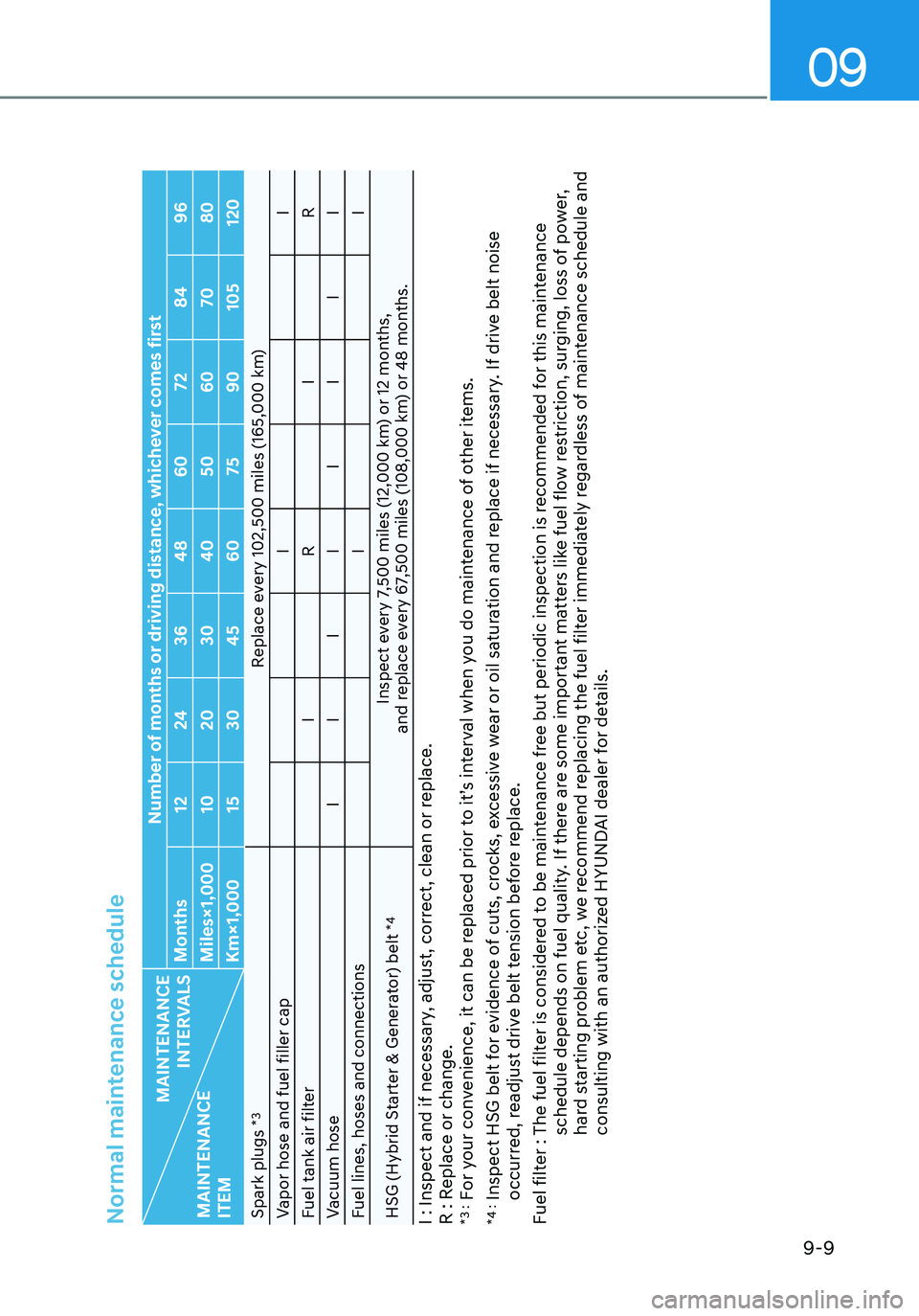
09
9-9
Normal maintenance schedule
MAINTENANCE
INTERVALS
MAINTENANCE
ITEM Number of months or driving distance, whichever comes first
Months 1224 3648 60 7284 96
Miles×1,000 1020 3040 5060 7080
Km×1,000 1530 4560 7590105 120
Spark plugs
*3
Replace every 102,500 miles (165,000 km)
Vapor hose and fuel filler cap II
Fuel tank air filter IR IR
Vacuum hose IIIIIIII
Fuel lines, hoses and connections II
HSG (Hybrid Starter & Generator) belt
*4
Inspect every 7,500 miles (12,000 km) or 12 months,
and replace every 67,500 miles (108,000 km) or 48 months.
I : Inspect and if necessary, adjust, correct, clean or replace.
R : Replace or change.*3 : For your convenience, it can be replaced prior to it’s interval when you do maintenance of other items.
*4 : Inspect HSG belt for evidence of cuts, crocks, excessive wear or oil saturation and replace if necessary. If drive belt noise
occurred, readjust drive belt tension before replace.
Fuel filter :
The fuel filter is consider
ed to be maintenance free but periodic inspection is recommended for this maintenance
schedule depends on fuel quality. If there are some important matters like fuel flow restriction, surging, loss of power,
hard starting problem etc, we recommend replacing the fuel filter immediately regardless of maintenance schedule and
consulting with an authorized HYUNDAI dealer for details.
Page 482 of 555

09
9-13
Maintenance under severe usage conditions
Maintenance itemMaintenance
operation Maintenance Intervals
Driving condition
Steering gear rack,
linkage and boots IInspect more frequently
depending on the condition C, D, E, F, G
Front suspension ball
joints IInspect more frequently
depending on the condition C, D, E, F, G
Disc brakes and pads,
calipers and rotors IInspect more frequently
depending on the condition C, D, E, G, H
Parking brake IInspect more frequently
depending on the condition C, D, G, H
Driveshaft and boots IInspect more frequently
depending on the condition C, D, E, F, G, H, I, J
Cabin air filter RReplace more frequently
depending on the condition C, E
Severe driving conditions
A. Repeatedly driving short distance of less than 5 miles (8 km) in normal temperature
or less than 10 miles (16 km) in freezing temperature
B. Extensive engine idling or low speed driving for long distances
C. Driving on rough, dusty, muddy, unpaved, graveled or saltspread roads
D. Driving in areas using salt or other corrosive materials or in very cold weather
E. Driving in the condition of inflowing sand or dust into engine
F. Driving in heavy traffic area
G. Driving on uphill, downhill, or mountain roads
H. Using for towing or camping, and driving with loading on the roof.
I. Driving for patrol car, taxi, commercial car or vehicle towing
J. Frequently driving under high speed or rapid acceleration.
K. Frequently driving in stop-and-go conditions
L. Engine oil usage which is not recommended (Mineral type, Semi-synthetic, Lower
grade spec, etc.)